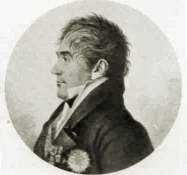Édouard Jean Baptiste Milhaud
| Edouard Jean-Baptiste Milhaud | |
|---|---|
 Edouard Jean-Baptiste Milhaud, Général de Division | |
| Born |
10 July 1766 Arpajon-sur-Cère, France |
| Died |
8 January 1833 (aged 66) Aurillac, France |
| Allegiance |
|
| Service/branch | Cavalry |
| Years of service | 1780s - 1815 |
| Rank | Général de Division |
| Battles/wars |
French Revolutionary Wars Napoleonic Wars |
| Awards |
comte d'Empire Name inscribed under the Arc de Triomphe |
Édouard Jean-Baptiste Milhaud (10 July 1766 – 8 January 1833) was a French politician, Général de Division, and comte d'Empire. He is considered one of the best generals of cavalry of Napoleon's army.
French Revolutionary wars
Born in Arpajon-sur-Cère (Cantal) as the son of Louis Amilhaud and Marguerite Daudé, Milhaud was commissioned as an officer in 1789. During the French Revolution, Milhaud was elected to the National Convention (which aimed at giving France a new political constitution) and in the proces of Louis XVI he voted for the death of the king. He defended Jean-Paul Marat against the attacks of the Girondins. In 1793 he was sent as a commissary to the armies of the Rhine and the Ardennes where he distinguished himself in his severity and his zeal in applying revolutionary ideological principles. Sent to the army of the Pyrenees, he was successful in aiding Dugommier in restoring order. He was recalled the next year and made a member of the military committee.
After the fall of Robespierre, Milhaud was threatened with arrest but saved from this fate by his colleagues on the military committee. His political role effectively over, he was recalled to the army and he became commandant of the 5th dragoons and was sent to the Army of Italy. Milhaud distinguished himself at Brenta and in the battle of Bassano. The following year he was again accused because of his role during the Terror but the Council of Elders decided not to act on the accusation.
Milhaud took an active part in the conspiracy leading up to 18 brumaire which was the day of the coup d'état by which General Napoleon Bonaparte overthrew the French Directory . Promoted to general de brigade in January 1800 he was employed in the army of England and was made commander of the 8th military division in the Vaucluse.
Napoleonic Wars
During the War of the Third Coalition Milhaud served under Joachim Murat in the 1805 campaign leading up to the great Battle of Austerlitz in which he took part. On the outbreak of the War of the Fourth Coalition in 1806, Milhaud distinguished himself at the Battle of Jena. On 28 October 1806, he forced the 6,000 men of the corps of Prince Hohenlohe to capitulate. At the end of 1806 he was promoted to general of division and in 1807 he distinguished himself at the Battle of Eylau.
His performance brought him to the attention of Napoleon Bonaparte, and having already been awarded the Légion d'honneur, on 10 March he was made a Count of the Empire. From 1808 until 1811 he fought in the Peninsular War. In November 1811 he was put on disability but in June 1812 he was recalled to active service and made commandant of the 25th military division. During the invasion of Russia, he became for a short time the military commandant of Moscow.
In 1813 he commanded a cavalry corps at the Battle of Leipzig. He fought, October 10, 1813, in the plain of Zeitz, one of the best fights of cavalry mentioned in French military annals, and in which he completely destroyed regiments of Austrian Latour and Hohenzollern Dragoons, as well as the Kaiser Chevau-légers. Based on his experience with these commands in 1814 Milhaud became Inspector General of the cavalry. During the first Restoration he was given command of the 15th military division by Louis XVIII.
During Napoleon's Hundred Days, he immediately supported Napoleon, and in the Waterloo campaign he commanded the IV Cavalry Corps. At the Battle of Ligny on 16 June 1815 with his cuirassier divisions he broke the centre of the Prussian army and helped to win Napoleon's last victory. Two days later at the Battle of Waterloo 18 June his divisions took part in the great general cavalry assault on the allied centre, a plan he had opposed but had to execute. The attacks ultimately proved a failure.
After the second restoration Milhaud was banished by King Louis XVIII as a regicide. After the July Revolution in 1830, he was called back to France, but died on 8 January 1833 in Aurillac.
References
- August Niemann (Hrsg.): Militär-Handlexikon. Adolf Bonz & Comp., Stuttgart 1881.
Further reading
- Senior Terry J., The Top Twenty French Cavalry Commanders: #20 General Edouard-Jean-Baptiste Milhaud, Napoleon Series, August 2002
- David, Jacques Louis. Portrait of Jean-Baptiste Milhaud (1766-1833), Deputy of the Convention,My Art Prints